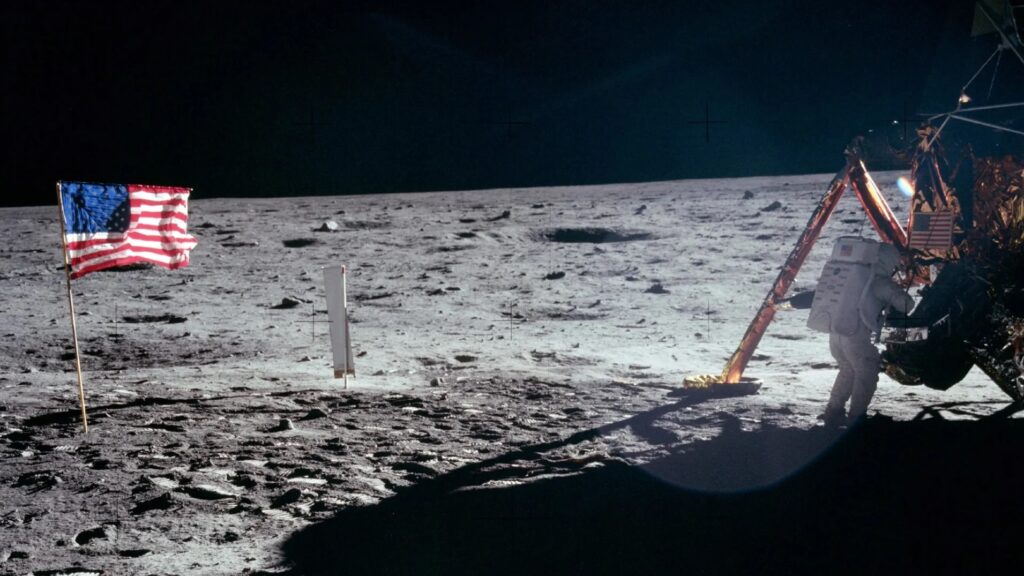21/07/2024
21/07/2024

NEW YORK, July 21: July 2, marked 55 years since Apollo 11’s historic flag-raising on the lunar surface, a momentous event during Neil Armstrong and Buzz Aldrin’s moonwalk in July 1969. This iconic moment, which took only 10 minutes of their two-and-a-half-hour moonwalking adventure, sparked extensive debate and discussion about the ownership and symbolism of the moon.
Matthew Ward, a senior lecturer in history at the University of Dundee in Scotland, emphasizes the profound symbolism of the American flag, which has been a powerful presence in key events in American history, from the Apollo moon landings to the raising of the flag at Ground Zero after 9/11. "It is difficult to think of any other flag that's so heavily invested in meaning. The Stars and Stripes expresses the spirit, history, and identity of an entire nation," Ward notes.
In the early 1990s, Anne Platoff, then with Hernandez Engineering Inc., compiled a NASA contractor report titled "Where No Flag Has Gone Before: Political and Technical Aspects of Placing a Flag on the Moon." Platoff explains that Apollo 11's flag-raising was purely symbolic. As a signatory to the United Nations Treaty on Outer Space, the US could not claim territorial rights to the moon. Despite this, the event was subject to domestic and international debates.
Congress amended NASA's appropriations bill to prevent the space agency from displaying flags of other nations or international associations on the moon during missions funded solely by the United States. Platoff notes that while the legal status of the moon was unaffected by the presence of a US flag, NASA was conscious of potential international controversy.
The flag-raising posed technical challenges for NASA engineers, who designed a flagpole with a horizontal bar to make the flag appear as if it were flying despite the moon’s lack of atmosphere. Considerations included weight, heat resistance, and ease of assembly by astronauts in restrictive space suits.
Buzz Aldrin later recounted in a Life magazine article the "almost mystical unification of all people in the world at that moment" as he and Armstrong planted the flag, which was purchased locally in Houston for $5.50. Aldrin described the difficulty in inserting the flagpole into the dense subsoil, noting it only went in a couple of inches and did not look very sturdy.
Platoff's research revealed that the six flags placed on the moon by Apollo missions were not all the same size. The flag planted during Apollo 17 in December 1972, the last moon mission, was unique as it had been displayed in the Mission Operations Control Room during previous missions before being taken to the moon by astronauts Eugene Cernan and Jack Schmitt.
The current condition of the lunar flags is uncertain. They may have degraded due to prolonged exposure to sunlight, a process Platoff refers to as "sun rot." The flags are likely brittle and possibly disintegrated over time, further damaged by meteoroid impacts.
Platoff, now a librarian, historian, and vexillologist at the University of California, Santa Barbara, addresses the common belief that the flags would be bleached white from sunlight exposure. While this occurs to some flags on Earth, the chemical process in the lunar environment is unclear.
In her 2011 research paper, "Six Flags over Luna: The Role of Flags in Moon Landing Conspiracy Theories," Platoff asserts that regardless of their physical state, the flags’ legacy as symbols of human exploration remains intact. She dismisses moon landing conspiracy theories, stressing the importance of teaching critical thinking.
"Do you really think it would be possible to maintain the level of cooperation from everyone involved in the Apollo Program to maintain the hoax for fifty-five years? Or is it more plausible that people working together were able to harness the power of science and technology to achieve the goal of landing astronauts on the moon and bringing them home safely?" Platoff asks. She concludes that while people are free to believe in hoax theories, it does not make them correct.


